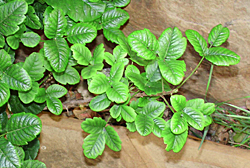- Tahoe’s Nevada Beach Tops the List of Hard-to-Book Campgrounds - 07/17/2024
- Cannabis Watershed Protection Program Cleans Up Illegal Grow Sites - 07/10/2024
- French Fire - 07/05/2024
Text & Photos by Seth Lightcap
 Whoa Tiger! Watch where you step! Poison oak is rampant this year. But you can’t stop running, hiking or biking. How do you avoid it?
Whoa Tiger! Watch where you step! Poison oak is rampant this year. But you can’t stop running, hiking or biking. How do you avoid it?
The first step in avoidance is proper identification. Poison oak can grow as a green plant, a dense thicket, or a crawling vine. Despite plant size the leaves are always clustered in a group of three. Usually the individual leaves resemble a small mitten with a wavy contour on one side that outlines a thumb.
In the spring and summer the leaves are green and waxy. As the summer dries up the leaves may turn a vibrant crimson. Poison oak thrives in shady damp locations but can survive in hot exposed areas. It is a hardy competitor and will quickly reestablish disturbed ground such as the sides of trails and campsites.
Poison oak’s toxic ingredient is the resinous oil called urushiol (“oo-roo-she-ol”). When urushiol contacts your skin it begins to bond with your skin cells. An allergic reaction occurs as your body recognizes the bound cells as toxins and sends out a cutthroat battalion of killer cells that destroy the urushiol and all the surrounding tissue. The rash and oozing blisters are the aftermath of your immune system’s overzealous warpath.
Allergic reactions happen when your body recognizes a substance it has previously deemed toxic. Ninety percent of people are allergic to urushiol with significant exposure. If you have been exposed but never got the itch, it’s likely that with the next exposure you will. That first exposure alerted your immune system and now it’s on the look out.
In most cases people who contact poison oak do not notice when it occurs. Maybe they casually stepped off trail to fix a bike. Maybe they petted a dog that had trampled through it.
Get in the habit of suspecting that every plant on trail could be poison oak. In time your knee-jerk reaction to avoid touching any plants will protect you from incidental contact. Direct contact is necessary to release the urushiol. However, beware when burning or trimming brush as the oil can be released into the air.
On overgrown trails exposure may be unavoidable. The only way to avoid a nasty reaction is to immediately clean all exposed skin, clothing and equipment. When quickly washed away the urushiol does not have time to bond with your skin. Urushiol can remain potent for up to five years. Letting those bike gloves sit for two weeks won’t help.
 Luckily several cleansers are available that help wash away unbound urushiol. Tecnu is one popular brand. The petroleum-based product works like an organic paint stripper and binds to the urushiol before it bonds with your skin. Apply Tecnu while still dry and then rinse thoroughly with cold running water. Do not rinse with hot water as the heat opens your pores and lets in the urushiol.
Luckily several cleansers are available that help wash away unbound urushiol. Tecnu is one popular brand. The petroleum-based product works like an organic paint stripper and binds to the urushiol before it bonds with your skin. Apply Tecnu while still dry and then rinse thoroughly with cold running water. Do not rinse with hot water as the heat opens your pores and lets in the urushiol.
When washing without a special cleanser imagine having to remove a sticky pine sap. Regular soap won’t cut it. Try acetone, alcohol, or a waterless hand degreaser like Goop. Clothing can be washed on a standard heavy rinse cycle as the agitation and abrasive soaps will remove the urushiol.
Most people develop a rash about 3 to 5 days after exposure. If the itchy rash appears keep the area clean and immediately consider where you were exposed. You may be continually infecting yourself using something still contaminated. The rash may blister and weep fluid. This fluid is not contagious.
It will take two to three weeks for the rash to heal. If the itch is unbearable try a new product called Zanfel. It works to remove bound urushiol and usually eliminates the itch. If symptoms are severe or spreading dramatically go see a doctor. Urushiol may be traveling within your blood stream. This is called a systemic reaction and you’ll need treatment with steroids.
Don’t be foolish. Stay away from poison oak even if you think you’re immune. Learn how to identify the plant and train your gaze to scan terrain before you step. Only then can you rest easy that your woodsy escapade won’t ooze back to haunt you in the days to come.













